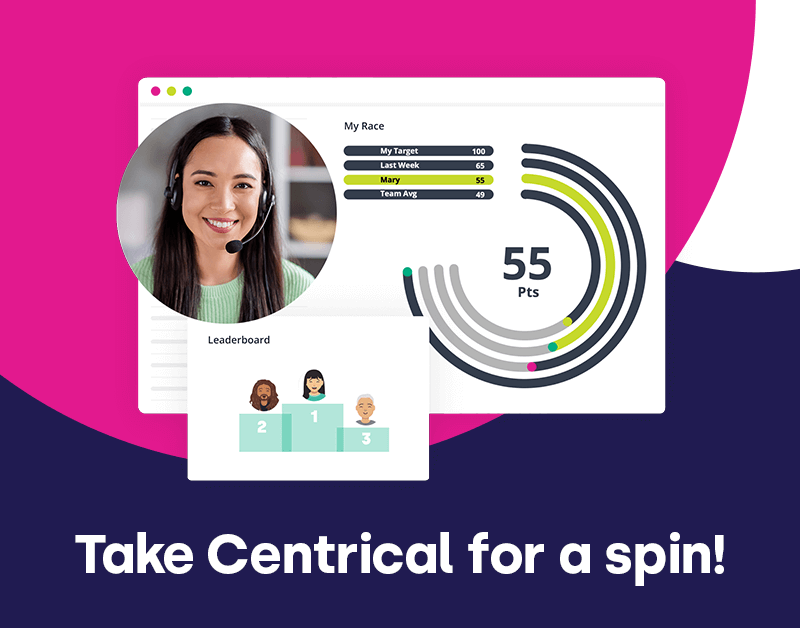This article was originally published as part of Centrical CEO and founder Gal Rimon’s “The Future of Work” newsletter. For more insights on CX, EX, and industry thought leadership, subscribe today and follow Gal on LinkedIn.
The BI Paradox: Why More Data Doesn’t Always Translate into Better Business Outcomes
In my two decades working in Business Intelligence before founding Centrical, I saw the same pattern: despite putting the spotlight on them, the flood of data never solved the problems.
Working with consulting giants like EDS and Deloitte, I saw that companies were bombarded with charts, KPIs, and dashboards. But the challenge was always the same: how to turn these insights into action.
Despite providing solutions to some of the world’s biggest companies, we consistently struggled to bridge the gap between business strategy and execution.
The missing link was the human element—the ability to act on data. No matter how much data we generated, execution fell short. It wasn’t driving real business change. I dubbed this phenomenon “Business Gossip.” Plenty of data, but very little action.
From Business Gossip to Business Change: Transforming Data into Action at Scale
While leading my previous company, about 15 years ago, we partnered with an insurance provider seeking to improve revenue and profitability. After a month of analysis, we uncovered a key issue: despite having strong value propositions, most customers and prospects stuck to the same basic plants. The Pareto principle held true.
We identified 3 challenges:
🚧 Matching the right insurance plan to the right customer;
🚧 Engaging customers with optimized plans;
🚧 Scaling the process effectively.
The first challenge was straightforward: we built data models, segmented customers, and ranked value props accordingly.
The second challenge required a shift toward customer-centricity and omnichannel engagement. Every interaction across all channels had to deliver a seamless experience and offer the Next Best Action or offer.
The third challenge was the most complex, requiring us to integrate different technologies: a data warehouse, data mining, campaign management, website integrations, learning systems, and more.
The results were extraordinary: higher revenue, improved conversion rates, better sales agent efficiency, and even increased customer satisfaction.
This experience became the foundation for my next venture, Centrical.
The Next Chapter: Building Centrical
After selling my company, I was determined to replicate our success with the lessons I’d learned. These key insights became my guiding principles:
- Data must be actionable, bridging the gap between strategy and execution.
- Business impact comes from changing the behaviors of customers or employees.
- Training should focus on driving the right behaviors.
- A feedback loop is essential: analyze, adjust, and improve continuously.
These insights formed the foundation of Centrical, an Employee Performance Experience platform designed to create employee-centric, personalized experiences using the vast amounts of data organizations collect on performance, behaviors, skills, and engagement.
However, my old nemesis, Business Gossip, soon resurfaced.
Even with our excellent results, managers were still drowning in BI dashboards that were not actionable enough. Our data showed that managers spent 60% of their time on data analysis, 20% on evaluations, and less than 20% providing direct support to their teams. In short, a mountain of data, with minimal action.
Enter AI: Revolutionizing the Manager Experience
With generative AI, we saw an opportunity to revolutionize the manager’s experience through a conversational AI-powered assistant.
Now, instead of spending hours going through dashboards, managers using our platform can simply ask AI for what they need (think Chat GPT).
For example:
- Q: “What’s my team’s biggest challenge this week?”
- AI Assistant: “Conversion rate.”
- Q: “Who are my low performers?”
- Q: “How can I help Dennis?”
- AI: “Dennis’ conversion rate is low due to weak probing questions. You can send him a roleplay training or schedule a shadow call with Jane, top performer.”
- Q: “Schedule a shadow call for Dennis with Jane.”
- AI: “Done. Dennis is scheduled for a shadow call with Jane.”
- Q: “Write me a kudos message for Jane in Yoda’s voice.”
- AI: “Hmmm, Jane, master of probing questions you are. With wisdom deep and insight sharp, your inquiries cut through the fog of uncertainty…”
With AI, managers become more engaged with their teams, saving 5-10 hours per week. In turn, employee performance improves and the managers’ relationships with their employees get stronger.
The bottom line? BI is not dead. Business analysts will continue to rely on it, but for managers, AI will increasingly take its place.
The era of static dashboards is fading. The era of AI-driven action is here.
Curious to learn how Centrical keeps the human experience central while leveraging AI? Discover more about our innovative solutions and strategies that bridge technology and the power of human connection.
Engage and motivate your frontline teams
Improve performance with an AI-powered digital coach
Deliver world class CX with dynamic, actionable quality evaluations
Boost performance with personalized, actionable goals
Nurture employee success with the power of AI
Listen and respond to your frontline, continuously
Drive productivity with performance-driven learning that sticks
Drive agent efficiency, deliver client results
Keep tech teams motivated and proficient on products and services while exceeding targets
Maintain compliance while building customer happiness and loyalty
Enlighten energy teams to boost engagement
Engage, develop, and retain your agents while driving better CX
Improve the employee experience for your reservations and service desk agents







 Madeleine Freind
Madeleine Freind
 Natalie Roth
Natalie Roth Linat Mart
Linat Mart












 Doron Neumann
Doron Neumann Gal Rimon
Gal Rimon Daphne Saragosti
Daphne Saragosti Ella Davidson
Ella Davidson Ariel Herman
Ariel Herman Ronen Botzer
Ronen Botzer